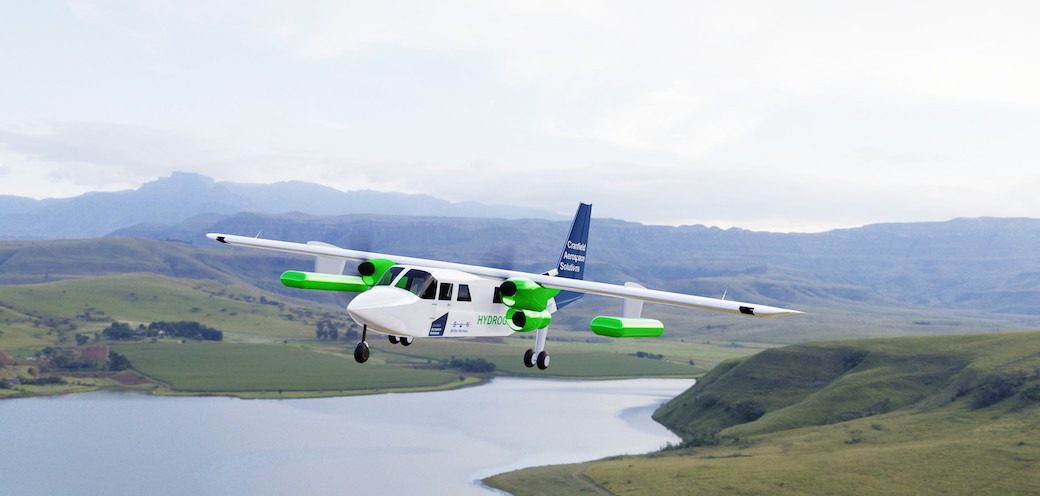
Conversion of Britten-Norman’s Islander is the first step in a four-phase plan to produce zero-emission aircraft.
Preparing to merge to create the first OEM for hydrogen-powered zero-emission aircraft, the UK’s Cranfield Aerospace Solutions and airframe manufacturer Britten-Norman have outlined a multiphase plan to develop clean-sheet aircraft with up to 100 seats using fuel-cell propulsion technology.
Phase One is focused on flying a nine-passenger Britten-Norman Islander demonstrator in 2024 as part of plans to certify the conversion for retrofit and factory installation. Service entry is scheduled for 2026.
A larger hydrogen-electric aircraft based on a derivative from the current Britten-Norman stable would follow in Phase Two, while Phase Three would involve an all-new regional airliner with up to 50 seats for service entry in the early 2030s.
A fourth phase outlined for the mid-2030s would see the product range expanded to include a new aircraft with up to 100 seats.
Privately owned Britten-Norman has been producing aircraft for almost 70 years and has built about 1,300 piston- and turboprop-powered Islanders, while Cranfield Aerospace Solutions (CAeS) has been designing and certifying complex aircraft modifications since it was established 30 years ago by Cranfield University.
The combination positions the new venture ideally between traditional large OEMs and the raft of startups in the hybrid-electric and hydrogen-propulsion market, says CAeS CEO Paul Hutton.
“Airbus and Boeing are putting hundreds of millions of dollars into this area, and they’ll get there eventually,” he says. “But they’ll just get there very slowly, because they’re focusing on the larger aircraft, and that will just take longer because the technology is not mature.”
At the other end of the scale are startups, “most of which will fail because you can’t create engineering capability in the short term in aerospace by just putting engineers together with money,” Hutton says.
“In the middle, you’ve got a relatively small number of companies that are behaving with the agility of a startup but have the credibility of understanding aerospace because they’ve been around for many years,” he notes. “We fit right into that group.”
The companies were brought together initially under the UK government-backed Project Fresson to equip the Islander with hydrogen-electric propulsion. Project Fresson was launched in 2019 with a £9 million ($11.4 million) government grant to cover some of the projected costs of the Islander modification.
CAeS in 2022 secured £14.4 million in funding from investors—including HydrogenOne Capital Growth, Safran Corporate Ventures and the United Arab Emirates’ Strategic Development Fund. Those backers have agreed to invest up to a total of £10 million in the merged company.
Cranfield University and Motus Ventures will retain their shares, and Britten-Norman’s existing owners—including lead investor Alawi Zawawi—are joining the new company. The investment underpins a Series B funding round now underway to raise an additional £30 million to support growth of the merged entity.
CAeS recently completed characterization flight tests of an unmodified Islander destined to be converted into the demonstrator by replacing one of its two piston engines with the fuel-cell propulsion system (FCPS). To develop the retrofit, CAeS has partnered with UK companies Ricardo for the fuel-cell system, Evolito the electric motor and Reaction Engines the heat exchanger to cool the fuel cells.
CAeS says the fuel-cell propulsion system will generate 240 kW of electrical power and produce up to 220 kW from the motor. Replacing the Islander’s standard 260-hp Lycoming O-540, the FCPS will deliver more than 110% of the output power of the original engine and at least 53% of the total aircraft thrust.
Unlike most fuel-cell propulsion systems, the CAeS design does not include batteries for transient power needs such as a go-around. The company says it has “sized the hydrogen fuel-cell system so no battery energy storage is required and we control the HFCS power output directly to achieve the necessary responsiveness and stability without a buffer energy store.”
Both the HFCS and electric propulsion unit, which includes the motor and inverter/controller, will be installed in the Islander’s nacelle in a production-representative package, says CAeS Chief Strategy Officer Jenny Kavanagh. “When we fly next year, it will be a technology demonstrator representing a significant step toward the production solution.”
The demonstrator will have two heat exchangers mounted on the Islander’s fixed landing leg, sized to reject the full amount of heat the HFCS produces. “These . . . don’t represent the production solution, for which the design will be optimized into a smaller configuration more akin to the existing air intake,” Kavanagh says.
Due to the extra drag of the oversized heat exchangers, the demonstrator will house the pressurized gaseous hydrogen fuel tank inside the fuselage. The production design will have tanks mounted externally to existing structural hard points on the underside of the Islander’s wing.
Hutton describes the converted Islander as the “Prius of aerospace,” referring to the Toyota hybrid car, because the zero-emission aircraft could evolve into a “green super-commuter” on routes between shorter city-pairs in areas such as California.
“We’re working already with the team at Britten-Norman to look at how can we make the aircraft look more modern and attractive,” Hutton says. “This super-commuter market becomes really quite exciting, and that’s just one step. So potentially by 2026 there could be a massive pull from the market and very little product to supply it.”





